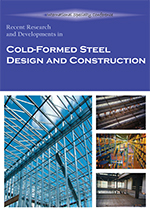Session Dates
24 Aug 2012 - 25 Aug 2012
Abstract
Plain C or Z- sections are two of the most common cold-formed steel purlins in use for roof systems throughout the world. Especially for Z- sections, their lapping ability provides continuity and double thickness material at the support regions results in greater performance and more economical designs. At the region just outside the end of the lap, the purlin may fail under a combination of high bending and shear. Design methods for these sections are normally specified in the Australian/New Zealand Standard for Cold-Formed Steel Structures (AS/NZS 4600:2005) or the North American Specification for Cold- Formed Steel Structural Members (2007). Both Effective Width Method (EWM) and the newly developed Direct Strength Method (DSM) can be used for the design. The DSM presented [Chapter 7 of AS/NZS 4600:2005, Appendix 1 of (AISI 2007)] is developed for columns and beams and is limited to pure compression and pure bending. The situation of combined bending and shear as occurs in a continuous purlin system is not considered. This paper presents a testing program performed at the University of Sydney to determine the ultimate strength of high strength cold-formed lapped Z purlins with two different lap lengths. Tests were also conducted both with and without straps screwed on the top flanges. These straps provide torsion/distortion restraints which may enhance the capacity of the purlins. Numerical simulations using the Finite Element Method (FEM) were also performed. The simulations are compared with and calibrated against tests. The accurate results from FEM allowed extension of the test data by varying the lap lengths. The results of both the experimental tests and FEM were used and plotted on the design interaction curves. The proposals for an extension to the DSM in combined bending and shear are given in the paper.
Department(s)
Civil, Architectural and Environmental Engineering
Research Center/Lab(s)
Wei-Wen Yu Center for Cold-Formed Steel Structures
Meeting Name
21st International Specialty Conference on Cold-Formed Steel Structures
Publisher
Missouri University of Science and Technology
Document Version
Final Version
Rights
© 2012 Missouri University of Science and Technology, All rights reserved.
Document Type
Article - Conference proceedings
File Type
text
Language
English
Recommended Citation
Pham, Cao Hung; Davis, Annabel F.; and Emmett, Bonney R., "Experimental and Numerical Investigations of High Strength Cold-formed Lapped Z Purlins under Combined Bending and Shear" (2012). CCFSS Proceedings of International Specialty Conference on Cold-Formed Steel Structures (1971 - 2018). 3.
https://scholarsmine.mst.edu/isccss/21iccfss/21iccfss-session6/3
Experimental and Numerical Investigations of High Strength Cold-formed Lapped Z Purlins under Combined Bending and Shear
Plain C or Z- sections are two of the most common cold-formed steel purlins in use for roof systems throughout the world. Especially for Z- sections, their lapping ability provides continuity and double thickness material at the support regions results in greater performance and more economical designs. At the region just outside the end of the lap, the purlin may fail under a combination of high bending and shear. Design methods for these sections are normally specified in the Australian/New Zealand Standard for Cold-Formed Steel Structures (AS/NZS 4600:2005) or the North American Specification for Cold- Formed Steel Structural Members (2007). Both Effective Width Method (EWM) and the newly developed Direct Strength Method (DSM) can be used for the design. The DSM presented [Chapter 7 of AS/NZS 4600:2005, Appendix 1 of (AISI 2007)] is developed for columns and beams and is limited to pure compression and pure bending. The situation of combined bending and shear as occurs in a continuous purlin system is not considered. This paper presents a testing program performed at the University of Sydney to determine the ultimate strength of high strength cold-formed lapped Z purlins with two different lap lengths. Tests were also conducted both with and without straps screwed on the top flanges. These straps provide torsion/distortion restraints which may enhance the capacity of the purlins. Numerical simulations using the Finite Element Method (FEM) were also performed. The simulations are compared with and calibrated against tests. The accurate results from FEM allowed extension of the test data by varying the lap lengths. The results of both the experimental tests and FEM were used and plotted on the design interaction curves. The proposals for an extension to the DSM in combined bending and shear are given in the paper.



